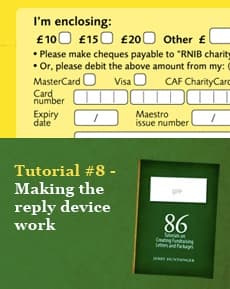Tutorial 8: Making the reply device work
When should you omit a reply device? Almost never!
- Written by
- Jerry Huntsinger
- Added
- February 21, 2019

The two major exceptions are:
- When you are sending a high-level letter of appreciation to major donors and the enclosure of a reply envelope might be too obviously promotional.
- When you are writing an appeal for a major gift – perhaps thousands of dollars and, again, enclosing an envelope would smack too much of commercialism.
Creating the reply device
Many professionals formulate the offer and appeal. And then, before creating the letter or the rest of the package, they create the reply device.
Why? Because a donor will often become highly motivated to make a donation and decide, YES, I’ll send a gift. But then, the donor will put the reply device and reply envelope in the same pile of other bills to be paid.
Days later, when the donor goes back to the pile of bills, the reply device is found again. But unless the reply device rekindles the enthusiasm, the donor will often throw it away, unencumbered by the fires of emotion.
If the reply device is so strong and so compelling that when the donor first reads it he cannot resist making a gift immediately then you have achieved your purpose.
Also, many donors are quite unsystematic in the way they read their direct mail fundraising pieces and they often read the reply device to find out what the appeal is all about.
The reply device must be strong and it must contain the following features:
- The name and mailing address of your organisation and exactly how the payment is to be made. (And don’t forget the logo. GC.)
- A statement concerning the tax deductibility/credits (if relevant) and possibly a statement concerning the financial reputation of the organisation.
- A re-statement of the appeal in a headline form. For example, if your appeal is to raise funds for a new ambulance for the rescue squad, then the reply device might have the headline: rescue ambulance.
- Whatever characterised your mailing package should be repeated on the reply form. Then you can have some statement that more fully details the nature of the appeal, such as, ‘Here’s my gift for the rescue ambulance and for all the other emergency needs facing our rescue squad.’
If you are sending a premium in response to the gift, then you might add a sentence saying, ‘Please send me one of your lifesaving posters on what to do when disaster strikes.’
(And if you’ve included such a check box option and the donor does not tick that box, DO NOT send the poster. Your donor will get mad. Great way to destroy a relationship. GC.)
Many times a reply slip will contain a picture of an individual who needs assistance and this picture is often the same picture that may appear on the letter, or in the newsletter, or some other part of the package.
Or, the illustration can be that of the premium or, in the case of the rescue squad appeal, perhaps a picture of the rescue squad in action at the site of a disaster.
- The name and address of the donor.
- If you have requested a specific amount in the letter, then this amount must appear once again on the reply slip, as should an indication of the possibility of sending more than the requested amount.
- If you have not asked for a specific amount, you might still wish to use prompts with a box by each amount, such as $10, $25, $50, etc.
Do not give your donor too many choices. As far as possible, list an amount that represents the amount the donor is most apt to give, plus provision for a gift that will have an upgrading effect. For your $100 donors you would never put a dollar amount of $10 or $25. And for your $25 donors you would not put a dollar amount of $5 or $10.
- Along with the dollar amount, there should be a box or a line indicating another amount. This gives the donor a chance to make a larger gift – or alas, perhaps a smaller gift – but it allows the donor some flexibility in the final decision.
(If you really want to be donor friendly, instead of providing another amount, provide a box with the wording ‘I prefer to give $__ '. Or you can even say, ‘Surprise us!’ GC.)
- The physical format of the reply device has several characteristics:
a. It is most often a separate piece from all other parts of the mailing package.b. A contrasting choice of colour for paper and ink should be used to make the reply device stand out from the rest of the package.
(I like to link the reply device and the reply envelope in some way – colour, a picture, graphic design. It helps the donor mentally pair the two. GC.)
c. The size must be such as to comfortably either fit into the reply envelope or fold down into the reply envelope
- Sometimes, the reply device can be connected to the letter, but this is rarely done today. Many years ago, the letter and the reply device were a standard combination, but testing has indicated that in most cases a separate reply device brings in more response.
(To reduce hand-matching in the mailing house, there are production formats now that allow you to print the reply device and letter on one sheet of paper, but when it folds down, the reply device gets cut off and falls inside the letter. Wonderful invention. G.C.)
Some final thoughts on the reply device
- The basic question you must ask before you design the device is this:
- Exactly what do you want the donor to do?
And once you have the answer to that question, your reply device must carry it out. It isn’t simply that you want the donor to send money, but that you want the donor to send a certain amount of money, for a certain project, for a certain reason, for a certain premium, to reach a certain goal, etc.
In a way, the reply device is an agreement or a contract between the donor and the charity and many a donation has been lost because the reply device did not clearly state the terms of the contract.
- Try using a numbered reply device. This gives a feeling of exclusiveness to the appeal.
- Avoid legal phrases. Even though the reply device may be worded in the terms of a contract, the phrases must not be written as though they were created by a lawyer.
- When using variable dollar prompts, the first should be the amount you wish the donor to give.
- The use of a deadline on the reply device, with the deadline printed in bold print, will ensure the appeal gets more attention.
- You can print a special paragraph on the reply device slanted to an inactive donor or patting a major donor on the back.
(Great idea to design a box on the reply device where you can personalise a message for different donor segments. GC.)
- And yes, when you use a string of suggested gift amounts, circle the amount you wish the donor to give and put in an asterisk, saying, ‘Please give this amount if you can.’
(This works. But try and make it authentic, perhaps by linking it directly to the offer. Think twice about using it on mailings to your existing donors. Donors have become savvy about this and see it as a mass mail gimmick. GC.)
© SOFII Foundation 2010-2014.

















